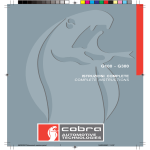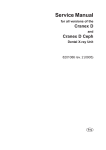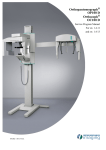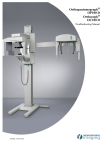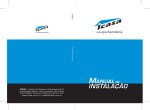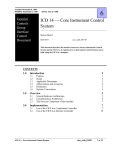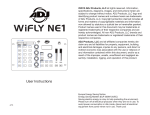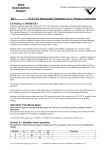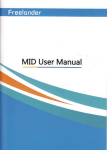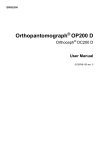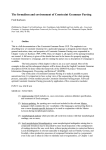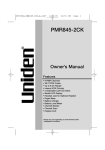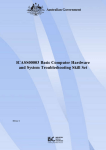Download Orthopantomograph OP100 Orthoceph OC100
Transcript
Orthopantomograph® OP100 Orthoceph® OC100 Electrical Operation & Wiring 11/2002 63467-4AB Copyright © 2002 by Instrumentarium Imaging Documentation, trademark and the software are copyrighted with all rights reserved. Under the copyright laws the documentation may not be copied, photocopied, reproduced, translated, or reduced to any electronic medium or machine readable form in whole or part, without the prior written permission of Instrumentarium Imaging. Orthopantomograph® and Orthoceph® are registered trademarks of Instrumentarium Corporation. U.S. patents 4,641,336; 5,016,264; 5,425,065 and 5,444,754. German patent 4,344,745. Orthopantomograph® OP100 and Orthoceph® OC100 comply with UL and C-UL (File E157261). The original language of this manual is English. Instrumentarium Imaging reserves the right to revise this publication from time to time and to make changes in the content of it without obligation to notify any person of such revision or changes. Manufactured by Instrumentarium Imaging P.O. Box 20 FIN-04301 Tuusula FINLAND Tel. +358 10 394 6500 Fax. +358 10 394 6501 E-mail: [email protected] Internet: http://www.InstrumentariumImaging.com Table of Contents 1 Electrical operation, schematics and layouts ................................................... 1 1.1 1.2 1.3 1.4 1.5 Electrical block diagrams ........................................................................................ 1 Wiring diagram........................................................................................................ 2 Primary electronics .................................................................................................. 2 Differences between 230 VAC and 110 VAC use .................................................. 2 Power supply board (CODE 60113)........................................................................ 3 1.5.1 Line voltage jumper ..................................................................................................4 1.5.2 High voltage section ..................................................................................................5 1.5.3 Low voltage section ...................................................................................................5 1.6 1.7 1.8 CPU Board (CODE 60112) ..................................................................................... 5 Interface Board (CODE 60166)............................................................................... 8 X-ray generator........................................................................................................ 9 1.8.1 Filament Control Board (CODE 60114)....................................................................9 1.8.2 Inverter board (CODE 60115) ................................................................................11 1.8.3 Tube head assembly (CODE 66360) .......................................................................13 1.9 1.10 1.11 1.12 1.13 1.14 1.15 1.16 1.17 1.18 1.19 1.20 63467-4AB Automatic Exposure Timer (AEC) Board (CODE 60122) ................................... 14 Control panel (CODE 61160)................................................................................ 15 Patient positioning panel (CODE 60108).............................................................. 15 Head support lock.................................................................................................. 16 Halogen positioning lights..................................................................................... 16 Laser lights ............................................................................................................ 17 Remote exposure control ....................................................................................... 17 Ceph soft tissue display ......................................................................................... 17 Ceph nose support ................................................................................................. 18 Ceph up/down switch ............................................................................................ 18 Cephalostat L/R coding ......................................................................................... 18 List of documents .................................................................................................. 18 Instrumentarium Imaging i ii Instrumentarium Imaging 63467-4AB 1 Electrical operation, schematics and layouts 1 Electrical operation, schematics and layouts 1.1 63467-4AB Electrical block diagrams Instrumentarium Imaging 1 1 Electrical operation, schematics and layouts 1.2 Wiring diagram Copies of OP100 Wiring diagrams, see section List of Documents. 1.3 Primary electronics 1-phase electric power is fed through a 3-pole cable to the column where the cable goes inside the right side groove to the vertical carriage (connectors X 101 and X 122). Line filter is located under the lower shelf. Line filter ground is connected to the incoming 3-pole cable ground. Flat connectors or fixed screws are used. There are two line filter types: units without CE-marking have type S-093-4 (code 21297). Units from s/n 72000 with CE-marking: type S-124-10 or NM-124-10 (code 69025). WARNING Always make sure OP100 has a good protective ground. Main switch with power on indicator light is located under the vertical carriage. Main fuses are located below the vertical carriage. Both F1 and F2 are slow blow type for incoming main voltage 110 or 230 Vac: MAIN FUSES Fuse Rating 230 VAC Rating 110 VAC Size F1, F2 10 AT 15 AT 6.3 x 32 mm Note: In USA/Canada 15AT fuses are used also with 230VAC rating 1.4 Differences between 230 VAC and 110 VAC use 1.4.1 Software version 1.02.07 or higer Fuses 326 Littelfuse (slow blow) 10A @ 230 VAC, MDA-15 COOPER BUSSMAN (time delay) 15A @ 110 VAC DIFFERENCES BETWEEN 110 VAC AND 230 VACSW 1.02.07 FEATURE 2 110 VAC 230 VAC VOLTAGE RANGE 85 - 125 175 - 250 MAIN FUSES 15 AT 10 AT Instrumentarium Imaging 63467-4AB 1 Electrical operation, schematics and layouts DIFFERENCES BETWEEN 110 VAC AND 230 VACSW 1.02.07 FEATURE 110 VAC 230 VAC POWER BOARD JUMPER SWITCH ON RIGHT SIDE ON LEFT SIDE MANUAL EXPOSURE VALUES: PANORAMIC & SPECIAL MODES 57 - 63 kV, max 16 mA 66 - 85 kV, max 12 mA 57 - 77 kV, max 16 mA 81 - 85 kV, max 12 mA MANUAL EXPOSURE VALUES: CEPHALOSTAT MODE 60 - 85 kV, 12 mA PREPROGRAMMED EXPOSURE VALUES See User Program Pr 53 nor and Pr52 CCo READY FOR ORTHO ID YES READY FOR DIGIPAN YES ORTHO ZONE OPTION YES ORTHO TMJ OPTION YES ORTHO TRANS OPTION YES AEC VALUES 57 - 85 kV, 3.2 12 mA AEC & MANUAL OFFSET (Pr 52 CCO density) 1 - 10 1.5 57 - 77 kV, 3.2 16 mA 77 - 85 kV, 3.2 12 mA Power supply board (CODE 60113) Power Supply Board rectifies AC voltages and filters the unregulated DC voltages. Power Supply Board consists of two main parts: low voltage and high voltage parts. 63467-4AB Instrumentarium Imaging 3 1 Electrical operation, schematics and layouts WARNING Voltages in high voltage part of the power supply board can be deadly. the peak-to-peak voltage level normally exceeds 600 V. 1.5.1 Line voltage jumper Jumpers S1 or S2 are for setting the unit according to local line voltage: Switches the rectifier V4 to the 1500uF capacitors C 1 and C 2, located above the Power Supply Board, to be either full-wave rectifier (230 Vac) or half-wave voltage doubler (110 Vac) Connects the primary of the line transformer TF2 either parallel (230 Vac) or in series (110 Vac) Connects the primary of the line transformer TF1 either parallel (230 Vac) or in series (110 Vac) Connects signal “MAINS” to GND when 110V line voltage is selected. Signal “MAINS” indicates to the CPU board whether the unit is connected to nominal 110 Vac or 230 Vac line. This switch will determine the kV/mA table. WARNING The line voltage selection jumper must all be at the correct position; left for 230 VAC and right for 110 VAC NOTE Jumper connectors S1 or S2 from unit s/n 71505. 4 Instrumentarium Imaging 63467-4AB 1 Electrical operation, schematics and layouts 1.5.2 High voltage section In high voltage section (upper half of the PC board) there is a rectifier D 4 for line voltage and loading circuitry K1-K2-R6 for two capacitors C1 and C2, which are connected to the PC board through connector X 22. 1.5.3 Low voltage section In low voltage section (= lower half of the PC board) there are fuses, rectifiers and filter capacitors for low operating voltages: • 24 Vac (from transformer TF1) is fused by F2, rectified by D5 (to +34 V) and filtered by C3-C4-C5. 18 Vac (from transformer TF2) is fused by F3, rectified by D6 (to +25 V) and by D7 (to -25 V) and filtered by C7-C8. 12 Vac (from transformer TF2) is fused by F1. • • POWER SUPPLY BOARD FUSES FUSE RATING FUNCTION SIZE F1 6.3 AT or 10 AT +12 VAC 6.3 x 32 mm F2 6.3 AT +34 VAC 6.3 x 32 mm F3 2 AT +25 V, -25 V 6.3 x 32 mm NOTE F1 with 10 AT rating is needed, if the OP100 has with 5 projectors for double side patient positioning. List of indicators and test points, see Service Manual Vol.V Trouble Shooting. 1.6 CPU Board (CODE 60112) OP100 is a microprocessor controlled equipment. CPU Board monitors and controls all movements and other operations in OP100, except the Head support lock operation and Ceph soft tissue display. All key inputs, microswitches and optocouplers are read by the CPU Board. Accordingly the 63467-4AB Instrumentarium Imaging 5 1 Electrical operation, schematics and layouts CPU controls all operations by supplying control signals through it’s input/ output (I/O) and timer circuits. CPU The microprocessor and it’s memory/peripheral circuits are common 8-bit processor design: The microprocessor ICD31 (80C32) has 8 I/O lines; mainly control signals for control panel by serial link. The address decoding is made by PAL-circuit ICD25 (22V10). OP100 main program is stored in EPROM ICD29 (27512, white label) and service programs in EPROM ICD 28 (yellow label). RS-232 RS-232 driver ICD37 (MAX232) is for two RS-232 serial links; one serial link is divided into two links by PAL-circuit ICD25 (22V10). RESET CIRCUIT ICA2 (TL7705) is a RESET generator. In the hardware there is also a “watchdog” feature. If the software does not frequently generate pulses in WDRFS signal, the voltage at pin 2 of ICA2 falls too low and activates the RESET signal. Switch S 1 resets the CPU. TIMER CIRCUITS The three timers of ICD27 (8254) and timer 2 of ICD25 (8254) generate clock frequencies for the stepper motor drivers in Interface Board by dividing the 1.5 MHz clock signal. Timers 0 and 1 of ICD25 (8254) count the frequencies AECFRQ and MAFRQ from the optoisolators ICD36 and ICD34 (6N136). +5V VOLTAGE REGULATOR ICA1 (4962) regulates +5Vdc supply voltage for CPU Board from incoming unregulated +25V. PARALLEL INPUTS/OUTPUTS ICD’s 6, 7, 15 to 18 (74ACT244) are input buffers. There are 40 inputs in use, of which 4 are optoisolated and there are 8 unused inputs, of which 5 are optoisolated. ICD’s 9 to 13 and 19 (74HC273) are output drivers. There are 34 outputs in use, of which 15 are optoisolated and there are 14 unused outputs, of which one output is optoisolated, two outputs are not connected. I/O from I/O drivers to connectors is buffered and protected according to use: – Relay drives are buffered by ICD38 (2804, Darlington driver). – Signals to X-ray generator (Filament Drive Board, Inverter Board and Tube Head Assembly) are optoisolated by seven quad-optoisolators ICD’s 1 to 5, 14 and 20. – Rest of the I/O signals are protected by serial resistors. 6 Instrumentarium Imaging 63467-4AB 1 Electrical operation, schematics and layouts SERVICE JUMPER A 3-pin connector X 10 under the memory chips has a jumper normally plugged to the right. When the jumper is moved to the left, it brings the unit to the Service mode. OPTION JUMPER Jumper X 11 is an option switch, normally in “off” position. When switched “on”, the OP100 can be demonstrated normally, but the exposure is prevented. This feature can be used eg. in exhibitions. GROUNDING There are three separate ground levels in the CPU Board: 1 The actual processor ground level (GND for +5V) 2 The generator ground-level (GND1) from Filament Control Board and Inverter Board (from connector X 4, pins 22, 23, 25 and 26). Connected to several optoisolators. 3 AEC-ground level (GND2) from AEC-Board (from connector X 8, pin 12). Connected only to ICD14, pins 9 and 15. GND is isolated from GND1 and GND2 in CPU Board by optoisolators, to eliminate noise and RF interference problems, but connected inside the Tube Head Assembly and in the Power Supply Board. 63467-4AB Instrumentarium Imaging 7 1 Electrical operation, schematics and layouts LIST OF SWITCHES: Swith / Jumper S1 X 11 X 13 X 10 X 14 Signal CPU Reset Normal or Option Don´t care User, Service EPROM chip select Program options List of indicators and test points, see Troubleshooting Manual. 1.7 Interface Board (CODE 60166) Interface Board contains driver circuits for stepper motors and DC motors and drives projector and warning lights, under the control of CPU Board. STEPPER MOTOR DRIVERS Stepper motor drivers ICA’s 2, 4, 6 and 8 (L297) convert incoming frequencies to stepper motor control sequences, and the half-bridge drivers ICA’s 3, 5, 7 and 9 (L298) drive the stepper motor windings. It is possible to increase power to the cassette holder down drive. This is done by removing X 21 jumper. Full power is available for down movement. This can be used if the cassette holder movement is jammed. DC MOTOR DRIVERS The Vertical carriage motor (Z-motor) and the Cassette lift motor (rack motor) are driven accordingly by circuits around pulse width modulators ICA10 and ICA11 (TL494). PROJECTORS, WARNING LIGHTS Positioning projectors are controlled by relay K1. The X-ray warning lights L1 and L2 are controlled by relay K2. Interface board OT: Laser lights are used in Ortho Trans units. Lasers are controlled by transistor T7. +15V VOLTAGE REGULATOR +15V operating voltages for PWM circuits ICA10 and ICA11 are regulated from unregulated +25V by ICA1 (LM317). 8 Instrumentarium Imaging 63467-4AB 1 Electrical operation, schematics and layouts List of indicators and test points, see Troubleshooting Manual. 1.8 X-ray generator 1.8.1 Filament Control Board (CODE 60114) Filament Control Board regulates filament heating level prior to the exposure (preheat control) and during the exposure (mA control), according to the digital references controlled by CPU Board. MA-REFERENCE Digital mA/preheat reference (signals KVMA0 - KVMA7) is latched to D/A converter ICA2 (7524) at 20 ms intervals by the negative edge of signal KVMACLK, while signal KVMASEL is being low at the same time. The +5V input reference from D 17 (LM336-5.0) is fed to the D/A converter via a buffer amplifier ICA1 (TL074). The output reference (MAREF) is also buffered by ICA1. MA-REGULATOR PWM (pulse width modulator) ICA3 (TL494) regulates the filament heating level by adjusting the duty cycle of the driver transistors so that the feedback voltage at pin 1 is the same as the reference voltage at pin 2. PWM FEEDBACK MULTIPLEXER The feedback voltage to the pin 1 of the PWM circuit ICA3 (TL494) comes through the multiplexer ICD2 (4052). The feedback source (from ICD2) depends on the control signals PREH and PREHREL: 63467-4AB Instrumentarium Imaging 9 1 Electrical operation, schematics and layouts STATUS preheat sequence normal exposure (mA-reference check) (stand by) PREH (TP3) active (0) active (0) passive (15V) passive (15V) PREHEL (TP4) active (0) passive (15V) active (0) passive (15V) FEEDBACKSOURCE PREHFB MAFB (MAFB) (MAFB) FILAMENT TRANSFORMER DRIVE Pulse Width Modulator ICA3 (TL494) drives the FET switches T1 and T2, which drive the filament transformer primary. Filament voltage is rectified and monitored as signal PREHFB. MA-FEEDBACK MONITORING CPU is able to check some voltage levels in the Filament Control Board by reading the frequency MAFRQ in different situations; The voltage to the U/F converter ICA4 (AD654) comes through the multiplexer ICD2 (4052). The voltage source (from ICD2) depends on the control signals PREH and PREHREL: STATUS preheat sequence normal exposure (mA-reference check) (stand by) PREH (TP3) PREHREL (TP4) active (0) active (0) passive (15V) passive (15V) active (0) passive (15V) active (0) passive (15V) VOLTAGESOURCE MAFB +5V MAREF LINEFB mA References and Feedbacks mA Nominal reference [V] Reference tolerances [V] Feedback tolerances [V] 2.0 0.48 0.46 - 0.50 0.37 - 0.59 2.5 0.61 0.59 - 0.63 0.50 - 0.72 3.2 0.78 0.76 - 0.80 0.67 - 0.89 4.0 0.97 0.95 - 0.99 0.86 - 1.08 5.0 1.22 1.19 - 1.24 1.11 - 1.32 6.4 1.56 1.52 - 1.59 1.42 - 1.69 8.0 1.94 1.90 - 1.99 1.77 - 2.11 10 2.43 2.38 - 2.48 2.22 - 2.64 10 Instrumentarium Imaging 63467-4AB 1 Electrical operation, schematics and layouts mA References and Feedbacks mA Nominal reference [V] Reference tolerances [V] Feedback tolerances [V] 12 2.92 2.85 - 2.98 2.66 - 3.17 16 3.89 3.81 - 3.97 3.54 - 4.24 The frequency MAFRQ is monitored by the CPU Board. – During preheat sequence CPU is able to measure the mA value (tube current), which enables the automatic preheat adjustment. – During normal exposure the CPU is able to calibrate reading of the U/ F converter ICA4 (AD654), since the U/F converter converts +5V reference into frequency. – During mA-reference check sequence CPU is able to check the reference that has been written to the D/A converter ICA2 (7524). – During stand-by the CPU monitors the LINEFB, which indicates the line voltage level. If MAFB does not rise, signal MAOK does not go active during the exposure. Measure test points on the board: TP1= GND TP2 = mAFB TP4 = mAREF +/- 15V VOLTAGE REGULATOR Supply voltages are regulated from unregulated +/- 25V by switching regulator ICA6 (L4962) for +15V and linear regulator ICA7 (LM337) for -15V. List of indicators and test points, see Troubleshooting Manual. 1.8.2 Inverter board (CODE 60115) Inverter Board regulates kV during the exposure, according to the digital reference controlled by CPU Board. Inverter Board consists of two main parts: High voltage section containing the FET bridge, and low voltage section containing the regulating, reference and pulsing circuits. WARNING Voltages in high voltage part of the inverter board can be deadly. The peak-topeak voltage level normally exceeds 600 V. FET BRIDGE (HIGH VOLTAGE) The FET-transistors in the H-bridge switch power to the high voltage transformer in the tubehead assembly. The higher the frequency in the FET bridge is, the lower the power level (kV*mA) in the tubehead assembly. In general, FET’s T1, 2, 7 and 8 conduct at the same time, and FET’s 3, 4, 5 and 6 accordingly, at the opposite phase. 63467-4AB Instrumentarium Imaging 11 1 Electrical operation, schematics and layouts KV REFERENCE Digital kV reference (signals KVMA0 - KVMA7) is latched to D/A converter ICA3 (7524) at 20 ms intervals by the negative edge of signal KVMACLK, when signal KVMASEL is high at the same time. The +5V input reference D21 (LM336-5.0) of the D/A converter is buffered by ICA1 (LM324). The output reference (KVREF) is also buffered by ICA1. KV REGULATOR kV regulator consists of KVFB buffer & error amplifier ICA1 (LM324), frequency modulator & comparator ICA2 (LM339) and pulse shaping circuit & flip flop ICD2 (4013). kV regulator regulates kV by adjusting the operating frequency of the high voltage FET bridge. PULSE TRANSFORMER DRIVE Drivers ICA4 and ICA5 (SG3635) drive the pulse transformers TF3 and TF4, which in turn drive the FET-switches of the H-bridge. KV-FEEDBACK MONITORING If kVfb does not rise, signal KVOK does not go active during the exposure. kV references and feedbacks kV Nominal reference [V] Reference tolerances [V] Feedbacktolerances [V] 57 2.85 2.79 - 2.91 2.75 - 2.95 60 3.00 2.94 - 3.06 2.90 - 3.10 63 3.15 3.08 - 3.22 3.05 - 3.25 66 3.30 3.23 - 3.37 3.20 - 3.40 70 3.50 3.43 - 3.57 3.40 - 3.60 73 3.65 3.57 - 3.73 3.55 - 3.75 77 3.85 3.77 - 3.93 3.75 - 3.95 81 4.05 3.96 - 4.14 3.95 - 4.15 85 4.25 4.16 - 4.34 4.15 - 4.35 Measure test points on the board: TP17 = GND TP18 = KVFB TP19 = KVREF BACK-UP TIMER Back-up timer ICA2 (LM339) disables the pulses, if the EXPENA signal is active for too long period (approximately 22 s). 12 Instrumentarium Imaging 63467-4AB 1 Electrical operation, schematics and layouts TEST SWITCH When testing the unit without x-rays, or without kV, TEST switch S, from board version 1.3 jumper X35, allows the activation of the exposure sequence and imaging movements regardless of the KVOK feedback. +15V/+25V SUPPLY VOLTAGES Supply voltages to Inverter Board are connected via the Filament Control Board. +25V is only present during exposure (when PREHREL signal is active in Filament Control Board). FUSE High voltage fuse in the Inverter Board, to protect the printed circuit board in case of short circuits. Fuse rating is 16 AFF, or 10 AT (from August 1994). INVERTER BOARD FUSE FUSE RATING FUNCTION SIZE F1 10 AT or 16 AFF INCOMING 310 VDC 6.3 x 32 mm List of indicators and test points, see Troubleshooting Manual. 1.8.3 Tube head assembly (CODE 66360) WARNING Voltages inside the tube head assembly are deadly. Maintenance of the tube head assembly can only be accomplished at the factory. There are no field serviceable parts inside the tube head assembly, and opening of the tube head assembly causes non-repairable damage and oil leakage. Tube head assembly consists of high voltage transformer TF1, voltage multiplier circuit D1-16 and C1-8, feedback resistors and the tube insert. TUBE HEAD ASSEMBLY BOARD (CODE 66370) 63467-4AB Instrumentarium Imaging 13 1 Electrical operation, schematics and layouts 1.9 Automatic Exposure Timer (AEC) Board (CODE 60122) AEC Board detects the radiation intensity through the cassette, converts the current mode signal from the detectors to voltage mode signal, and converts the voltage to frequency. The frequency (AECFRQ) is monitored by CPU Board. AEC-board has three adjustment points and all adjustments must be done after OP100 electronics have reached their operational temperatures. AMPLIFIERS Incoming current mode signal from the X-ray detectors D50 - D51 is converted to voltage mode signal and amplified by ICA1 (AD546) and ICA3 (AD706). OFFSET R3 is used to adjust the offset for operational amplifiers. It has been adjusted at the factory for 0 VDC measured from TP1. U/F CONVERTER The amplified voltage is converted to frequency signal by the voltage-tofrequency converter ICA4 (AD654), and the frequency (AECFRQ) is wired to the CPU Board. BASE FREQUENCY R27 is used for base frequency adjustment of 5 kHz ± 0.25 kHz at 0 kV /0 mA. The value is measured from TP2 or by using the “Sr 78 Fre” service program and reading the frequency from the display. GAIN R6 is the gain adjustment. It is adjusted by exposing through a special service tool (code 60441). Gain will be adjusted for as follows: 230 VAC: 73 kV / 12 mA 144 kHz ± 3 kHz 110 VAC: 73 kV / 10 mA 122 kHz ± 3 kHz List of indicators and test points, see Troubleshooting Manual. 14 Instrumentarium Imaging 63467-4AB 1 Electrical operation, schematics and layouts 1.10 Control panel (CODE 61160) Control Panel operates as a link between the operator and the CPU Board. It allows the operator to control OP100, and displays the status of the equipment to the operator. Control panel is monitored and controlled from CPU Board by a serial link. DISPLAY DATA IN Serial mode input signals from the CPU Board are buffered by ICD7 (40106), and wired to decoder circuit ICD4 (74HC138). Incoming data is decoded to drive the LED indicators L1L25 through ICD3 (M5450V). The 7-segment display drive is in a separate piggy-back pcb. The incoming data is decoded to drive the 7-segment displays through ICD1 and ICD2 (MC14489). KEY SWITCH DATA OUT Key switches S1, S2, S3, S4 and S6 (up-left-down-rightOK) are buffered by ICD6 (40106), decoded and multiplexed by circuits ICD2 (74HC165) and ICD4 (74HC138), and driven to the CPU Board through the serial link. Exposure switch S5 is wired directly to the CPU Board. It is possible to disable S5 function with Automatic and Manual mode operation. In this case the exposure with radiation is acticaed via remote control only. See Sr 89 rEo or Sr 89 COP options for details. VOLTAGE REGULATOR Supply voltage +5V is regulated by ICA5 (L4963). 1.11 Patient positioning panel (CODE 60108) Patient Positioning Panel includes all the key switches required when positioning the patient in OP100. The occlusal corrections according to the biting of the patient are indicated by three LED indicators. The three LED indicators H1 - H3 are driven from the CPU Board, and key switches S1 - S9 are wired to the CPU Board. Pressing any key will ground the CPU input line. Pressing any key (except “OK”) at power up causes Er 45 InP message. The Patient Positioning Panel is usually installed to the left hand operation. For the right hand operation, connect the panel to the right side of the lower shelf and use the connectors on the right side. Cable C 10 has double connectors (X 47/L, X 47/R and X 48/L, X 48/R) specially coded to inform CPU about the panel location. Ortho Trans models have two panels. 63467-4AB Instrumentarium Imaging 15 1 Electrical operation, schematics and layouts CPU Board detects whether the panel is installed to the right side by monitoring signal HOMESIDE in the CPU board. The operation is automatically switched to right handed configuration: right handed unit lifts the cassette rack from right and makes the exposure during counterclockwise rotation. NOTE Technically it is possible to have two Patient positioning panels (option code 61248) installed on both sides at the same time. In this case, the operation is left-handed, unless User Program “Pr 57 Hon” for bi-directional operation is selected. 1.12 Head support lock Head Support Lock consists of the magnet lock and the lock switches. There are three models for head support vertical movement: manual, fixed and fixed with Ortho Trans. • • • Manual movement is with friction.It is used in OP/OC100 models outside USA/Canada. Fixed model is used in OP/OC100 models in USA/Canada. All Ortho Trans models including upgrades use a fixed model, where the head support is removable. + 25 VDC Power is received from Power Supply board. When the OP100 power is on, current is drawn through magnet L2 and the head lock is on. Circuit is opened by pressing one of the switches S2 or S3 located at the sides of the head support assembly. NOTE CPU does not control the head support lock operation. 1.13 Halogen positioning lights For panoramic and TMJ positioning there are three halogen lights. Lights are controlled through Interface board. They do not operate in QA, CEPH nor TOMO operating modes. 16 Instrumentarium Imaging 63467-4AB 1 Electrical operation, schematics and layouts 1.14 Laser lights Ortho Trans models have two laser lights, one above the mirror and the other under the rotating cover. Laser lights are controlled by Interface board OT. There are not adjustable parts inside the laser light assembly. Lasers are lit when – Ortho Trans opton is active (Sr 89 COP / 7 P11 “on”) and – the TOMO collimator is selected and – lights on or occlusal correction keys are pressed on positioning panel. Laser lights 1.15 Remote exposure control A remote control exposure switch with cable (code 69961) can be connected to a junction box located at the rear of the column. This switch is normally open and it is directly wired to the CPU Board. Signals are logical level voltages. REMOTE EXPOSURE ONLY With “Sr 89 rEo” or Sr 89 COP one can configure OP100 so that exposure (Automatic and Manual Exposure control) can only be initiated from the remote exposure button. However, Test mode can always be demonstrated from Control Panel while “Sr 89 rEo” or “Sr 89 COP / 1 rE” is set “on”. This option is not available with some of the early CPU board versions. 1.16 Ceph soft tissue display The movement of the nose support changes the trimmer R 30 resistance. This board will show the nose support travel on two 7 segment displays with values “0 - 60”, where value represents the distance from the center of the ear holders to nose support. The actual distance is “value” + “60 mm”. +25 VDC Power is received from Power Supply board. ADJUSTMENTS There are trimmers R6 and R7 to adjust offset for “0” and gain for “60”. NOTE This board has no feedback to CPU board 63467-4AB Instrumentarium Imaging 17 1 Electrical operation, schematics and layouts 1.17 Ceph nose support Part of the nose support assembly is a trimmer R30, whose resistance value changes when the nose support is moved. This value is used as an input to Ceph Soft Tissue Display Board. 1.18 Ceph up/down switch Behind the ceph cassette holder there is a up/down switch for the vertical carriage. This key is wired to CPU board. These keys together with Patient positioning panel keys have the same function, but they are wired to different I/O ports. 1.19 Cephalostat L/R coding The coding for the cephalostat and x-ray tube orientation is controlled with X 110 (pin 4) and X 121 (pin4), located in the side boxes of the vertical carriage. These lines are wired into separate CPU I/O ports. When no cephalostat is attached, the program 5 cannot be selected from the control panel. Connecting cephalostat arm cable CC 2 to either X 110 or X 121 gives CPU the information to orient X-ray tube correctly. 1.20 List of documents The following OP100 documents should be part of this section: Code 68951-1S 60110-3S 60112-3S 60113-3S 60114-3S 60115-3S 60122-3S 60166-3S 60134-4S 60143-4S 66370-3S 60147-4S 60107-3S 60108-4S Document Wiring Diagram (from s/n 72000) Ceph Soft Tissue Display, Schematics CPU Board V1.5, Schematics (2 pages) Power Supply Board, Schematics Filament Control Board, Schematics Inverter Board, Schematics AEC Board, Schematics Interface Board V1.3, Schematics (2 pages) Head Support Lock, Schematics Ceph Up/Down Switch, Schematics Tube Head Assembly V1.4, Schematics Cassette Opto Sensors, Schematics Control Panel and Display, Schematics Patient Positioning Panel, Schematics In the case of missing or out-of-date documents please contact your distributor or Instrumentarium Imaging Technical Service. 18 Instrumentarium Imaging 63467-4AB Instrumentarium Imaging Italia S.R.L. Via Cassanese, 100 20090 Segrate (MI), Italy Tel. +39 02 21 30 28 1 · Fax +39 02 21 30 28 60 [email protected] Instrumentarium Imaging is constantly improving its products and reserves the right to change these specifications without notice. www.InstrumentariumImaging.com Instrumentarium Imaging Singapore 152 Beach Road #12-03A Gateway East 189721 Singapore Tel. +65 6391 8600 · Fax +65 6396 3009 [email protected] Instrumentarium Imaging Dental GmbH P.O.Box 2044, 77680 Kehl am Rhein, Germany Tel. +49 7851 932 90 · Fax +49 7851 932 930 [email protected] Distributor: 11/2002 © Instrumentarium Imaging Instrumentarium Imaging Inc. 300 West Edgerton Avenue, Milwaukee Wisconsin 53207, USA Tel. +1 800 558 6120, +1 414 747 1030 Fax +1 414 481 8665 [email protected] Instrumentarium Imaging France S.A.R.L. 4, Avenue des Roses 94386 Bonneuil Sur Marne Cedex, France Tel. +33 1 43 39 51 51 · Fax +33 1 43 39 75 75 [email protected] 63467-4AB Instrumentarium Imaging P.O.Box 20, FIN-04301 Tuusula, Finland Tel. +358 10 394 6500 · Fax +358 10 394 6501 [email protected]
























